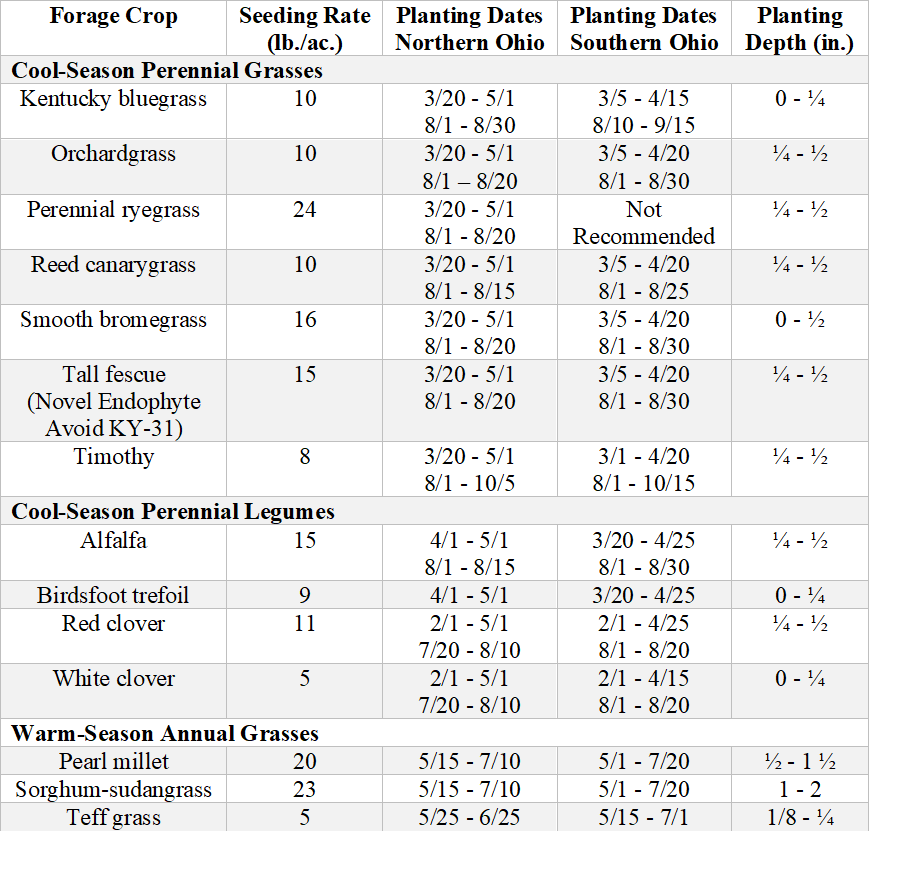



Selecting Forages for Your New Seeding
The spring seeding window for the most popular forages in our region is quickly approaching. Producers looking for guidance on how to choose the best forage for their system should always start with a soil test rather than a seed catalog. Whether you have farmed your site for decades or days, soil testing is essential for success.Once you know the characteristics of your soil, you can formulate a timeline to adjust fertility if needed, sow your selected seed, and set realistic expectations for production. Soil testing should be conducted when site history is unknown, when converting from a different cropping system (row crops, woodlands, turfgrass, etc.), or on a three-year schedule for maintenance.
Additional factors worthy of consideration prior to purchasing seed include site drainage, sunlight exposure, weed competition, forage harvest method, and feed value for the end user. Choosing a forage that is adapted to the conditions of the site may be more effective than adapting the site to fit an appealing forage.
Confronting the limitations of the planting site and implementing corrective action may take a whole season or more before the conditions are well-suited for establishing a new forage stand, but the results are worth the wait if you expect long-term success. It is ideal to begin preparing for planting in the growing season prior. Sometimes using a transitionary forage crop for the short-term can provide both improved forage production and help resolve current challenges. This can be especially helpful when site history is unknown.
Most Ohio forage producers looking to plant in the springtime have plans to establish a perennial cool-season forage stand. These forages will typically need planted by the beginning of May into a weed-free, well-drained, and firm seedbed. After germination they require two to three months before subjection to frequent mowing or grazing. If soil conditions are saturated past the ideal planting time or weeds take hold prior to seeding, it may be best to re-evaluate your plans. Most perennial cool-season forages have a second window for planting in late-summer or early-fall.
In a situation where spring planting is less than ideal, but you have already committed to planting something new, you can consider the use of a summer annual forage planted in late-spring or early-summer instead. These forages will grow quickly and die with first frost. Most can be harvested within 60 days of germination and produce two to three forage harvests. The forage manager can choose to terminate the summer annual prior to seeding a cool-season perennial in the fall or drill into the existing residue if weeds are suppressed. Another option is to follow the summer annual with a winter annual forage and pursue spring planting of a perennial stand again in the following year.
When establishing a stand that is a combination of grasses and legumes, proceed with caution regarding weed prevention and suppression. Treating weeds in a mixed stand is exceedingly challenging compared to grass-only or legume-only stands. Also be mindful of herbicide residual that could remain in the soil or plant matter from the previously grown crop. It may be ideal to establish the grass species first and frost-seed or inter-seed legumes after the first growing season to allow for the control of broadleaf weeds.
Recommendations for planting timeframes, seeding depths, seeding rates, site preferences, fertility requirements, and care during early establishment for various forage crops can be found in the Ohio Agronomy Guide. A partial selection of commonly requested information is included in the following table.

After choosing the forage type that best suits your management style and site limitations, browse varieties available from reliable seed dealers. Varieties of the same species may be better suited for hay than for grazing, mature at different rates, differ in nutritional value, and/or expected yield. Look for details on seed tags and compare production dates, germination rates, and pounds of pure live seed as indicators of quality. If planting a legume, be sure that the seed comes inoculated or with an inoculant packet of the appropriate rhizobia (soil bacteria).
Once you have settled on your best-case scenario, make a contingency plan, just in case Mother Nature has something up her sleeve that counteracts your ideas. Then, be patient for the right conditions to plant and allow adequate time for your new seeding to establish a healthy root system before first harvest.
Click here for a OSU video on forage species selection.


